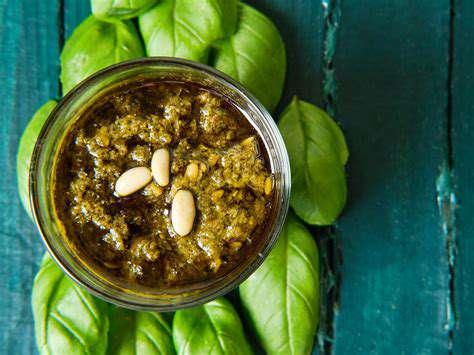Gluten Free Bread Baking: Soft, Chewy, and Delicious
Mastering Gluten-Free Hydration
Essential Considerations for Gluten-Free Hydration
Navigating the world of gluten-free baking requires a deep dive into hydration dynamics. Unlike traditional wheat flour, gluten-free flours interact with moisture in unique ways, dramatically altering the final product's texture. These alternative flours absorb water at different rates, making precision crucial. Too much liquid yields dense, gummy results, while insufficient hydration creates crumbly disappointments. The secret lies in meticulous experimentation - maintaining detailed records of hydration ratios and their effects will help you develop an intuitive understanding of each flour blend's behavior.
Each gluten-free flour variety demands specific attention. Tapioca-heavy blends, for instance, behave distinctly compared to rice-flour dominant mixes. This variability makes thorough knowledge of your ingredients non-negotiable. Precise measurement and constant vigilance during mixing become your greatest allies in achieving the perfect consistency and avoiding common baking mishaps.
Optimizing Hydration for Gluten-Free Breads
Bread-making with gluten-free flours presents special challenges. Without gluten's natural elasticity, achieving proper structure becomes a hydration balancing act. The right moisture level creates dough cohesion, enabling proper rising and texture development. The ideal hydration produces that coveted combination of crisp crust and tender interior that defines excellent bread.
Monitoring dough consistency remains paramount throughout the process. Overly wet dough collapses during baking, creating dense loaves, while excessively dry mixtures struggle to rise properly. Through systematic testing of hydration levels, you'll discover the perfect equilibrium for your preferred flour blend and desired bread characteristics, gradually refining your gluten-free baking expertise.
Hydration Techniques for Specific Gluten-Free Flour Blends
Gluten-free flour combinations exhibit wide-ranging hydration needs. Xanthan gum-based blends, for example, typically require less water than those using guar gum. Recognizing your blend's unique properties is fundamental to hydration success. Begin with recommended baseline measurements, then adjust based on the dough's feel and appearance during preparation.
Mastering gluten-free hydration demands research and practice. The interplay between various flours, starches, and gums creates complex water absorption patterns. Consult experienced bakers, reputable blogs, and reliable online sources to gather insights for your specific recipes. With persistent effort, you'll develop an instinct for achieving perfect hydration every time.
Hydration and Gluten-Free Dough Development
Hydration's role in dough development cannot be overstated in gluten-free baking. Without gluten's structural proteins, proper moisture levels become the foundation for cohesive dough that maintains shape during proofing and baking. Each flour variety interacts uniquely with water, influencing the dough's development characteristics.
Mixing techniques require special attention with gluten-free doughs. Overworking hydrated dough creates toughness, while insufficient mixing of dry dough leads to crumbling. Continuous assessment of texture and consistency during preparation ensures properly developed dough that bakes into tender, delicious results. This careful approach to hydration forms the cornerstone of successful gluten-free baking.
Achieving the Perfect Rise and Structure
Understanding the Importance of Rise
Exceptional gluten-free bread requires mastery of the rising process. The interplay between yeast activity, flour properties, temperature, and hydration creates the foundation for proper lift. Gluten-free flours demand specialized rising techniques distinct from wheat flour approaches, making this knowledge critical for success.
The first proof stage establishes the bread's potential. Environmental factors like ambient temperature significantly impact different gluten-free flours' response to yeast, necessitating careful observation and adjustment throughout this crucial phase.
Flour Selection and Hydration
Your choice of gluten-free flour blend directly determines the bread's rise and texture. Binding agents like xanthan or guar gum prove essential for structural integrity during baking. Hydration balance remains equally vital - excessive water creates dense loaves, while inadequate moisture yields dry, crumbly results.
Systematic testing of various flour combinations and hydration levels helps identify the perfect match for your recipe. Since different brands produce varying outcomes, always consider manufacturer recommendations as your starting point for experimentation.
Yeast Activation and Proofing Techniques
Successful rising begins with proper yeast preparation. Using water at the ideal temperature activates yeast effectively, while maintaining consistent proofing conditions ensures predictable results. Remember that active dry yeast requires more time than instant varieties, so adjust your schedule accordingly.
Structure and Texture Development
Creating satisfying gluten-free bread texture presents unique challenges. The right combination of flours, hydration, and binding agents makes the difference between mediocre and exceptional results. Understanding these interactions helps achieve desirable chewiness and airy crumb structure.
Incorporating ingredients like flax or chia seeds can enhance both texture and flavor complexity. These additions contribute to improved mouthfeel while adding nutritional benefits to your baked goods.
Baking Techniques and Oven Management
Proper baking methods complete the process of creating excellent gluten-free bread. Accurate oven temperature and even heat distribution are mandatory. Techniques like using Dutch ovens or baking stones promote uniform baking and superior crust development, though baking times will vary based on loaf size and flour composition.
Troubleshooting Common Issues
Problem-solving forms an essential part of the gluten-free baking journey. Whether addressing collapsed loaves, dense texture, or excessive dryness, identifying root causes leads to effective solutions. Maintaining detailed baking logs and understanding your flour blend's peculiarities will help you diagnose and correct issues systematically.
Through persistent attention to these factors, bakers can consistently produce gluten-free bread with professional-quality structure, texture, and flavor.

- Smart Food Storage: Keep Your Groceries Fresh Longer
- Simple Pasta Dishes: Weeknight Wonders
- Seasonal Cooking: Fall Harvest Recipes & Produce Guide
- Baking with Kids: Fun & Simple Cookie Decorating
- Authentic Irish Stew: Hearty and Comforting
- How to Store Avocados: Ripening and Storing
- Oven Baked Dinners: Less Mess, More Flavor
- Exploring Spanish Tapas Desserts: Churros and Flan
- Cooking with Spices: A Beginner's Flavor Guide
- Quick & Easy Stir Fries: Healthy and Delicious
- Cooking for Special Diets: Allergies and Intolerances
- Kitchen Organization for Small Spaces: Maximizing Every Inch